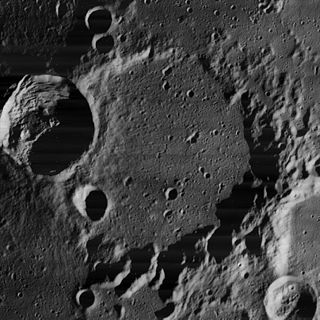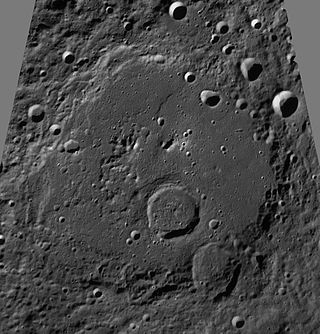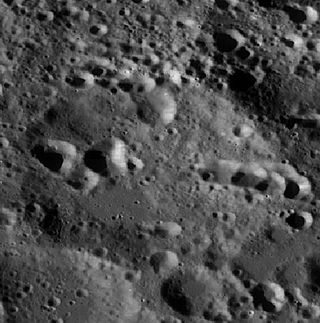
Chacornac is an irregular lunar impact crater attached to the southeast rim of the crater Posidonius. It lies just to the east of the Mare Serenitatis, and north of the crater Le Monnier. The crater is named after French astronomer Jean Chacornac.

Abenezra is a lunar impact crater located in the rugged highlands in the south-central section of the Moon. Abenezra is named after the Sephardic Jewish sage, poet, biblical commentator, and astrologer Abraham ibn Ezra. It is attached along the southeast rim to the crater Azophi. To the northeast lies the crater Geber, and further to the southeast is the larger Sacrobosco.

Appleton is a heavily eroded lunar impact crater that lies in the northern hemisphere on the far side of the Moon. To the northwest are the craters Von Neumann and Campbel. The smaller Golovin lies to the northeast, while further to the southwest is the Mare Moscoviense.

Barnard is a lunar impact crater that is located near the eastern limb of the Moon. It is attached to the southeast rim of the large crater Humboldt, and Abel lies directly to the south. To the northeast is the crater Curie, while to the southeast is the Mare Australe.

Blanchinus is a lunar impact crater that is situated in the rugged south-central highlands of the Moon. The crater is named after Italian astronomer Giovanni Bianchini whose Latinized name is Blanchinus. Adjacent to the south of Blanchinus is the crater Werner, and La Caille is attached to the northwest rim. West of the crater is the prominent formation Purbach.

Boyle is a lunar impact crater that is located in the southern hemisphere on the rugged far side of the Moon. It is adjacent to the larger crater Hess to the southeast, and lies about midway between the craters Alder to the north-northeast and Abbe to the south-southwest.

Becquerel is a lunar impact crater that lies in the northern hemisphere on the far side of the Moon. This is an ancient and heavily worn formation that is now little more than an irregular buri in the surface. The outer rim has been worn and reshaped until it forms a rugged, mountainous region around the flatter interior.

Bragg is an ancient lunar impact crater that is located on the far side of the Moon, just beyond the northwest limb. This formation has been heavily eroded and reshaped by subsequent impacts, leaving an irregular depression in the surface. The most intact portion of the rim is along the western face, while the northern and eastern rim has been nearly worn away and is overlaid by several smaller craters. The most notable of these is Bragg H, which lies across the east-southeastern rim.

Barringer is a lunar impact crater that is located on the southern hemisphere on the Far side of the Moon, named after geologist Daniel Barringer. It is attached to the north-northeastern rim of the walled basin named Apollo, and lies to the southeast of Plummer. South of Barringer, on the floor of the Apollo basin, is the crater Scobee.

Brenner is an old lunar impact crater that lies in the rugged southeastern part of the Moon's near side. It is named after the Serbian-Austrian astronomer Spiridon Gopčević. It is located within one crater diameter northwest of the crater pair Metius and Fabricius.

Brunner is a lunar impact crater that is located along the eastern limb of the Moon, to the southeast of the Mare Smythii. At this location the crater is viewed from the edge, and so it is not possible to see much detail from the Earth. The visibility of this formation is also affected by libration. The crater lies to the southwest of the walled plain Hirayama, and to the east of the elongated crater Houtermans.

Goldschmidt is a large lunar impact crater of the variety commonly termed a walled plain. It lies in the northern part of the Moon's near side, and appears oval in shape due to foreshortening. The rim is actually relatively circular, although the western rim is overlain by the prominent crater Anaxagoras. Nearly attached to the southeast rim is Barrow, and the two formations are separated by a rugged rise about 30 kilometers across. Further to the south is Epigenes.

Xenophanes is a lunar impact crater that is located along the northwestern limb of the Moon. It is nearly attached to Volta, a similar formation to the south-southwest. To the northeast is the smaller crater Cleostratus. Xenophanes is significantly foreshortened when viewed from the Earth, hindering observation.

H. G. Wells is a lunar impact crater that is located on the far side of the Moon, behind the northeastern limb. It lies to the south of the crater Millikan, and to the northeast of Cantor. Just to the southeast is the smaller Tesla. The crater is named after the author H. G. Wells whose works include the 1901 novel The First Men in the Moon.

Campbell is a large lunar impact crater that is located in the northern hemisphere on the far side of the Moon. It lies to the southwest of the walled plain D'Alembert, an even larger formation. If Campbell were located on the near side of the Moon as seen from the Earth, it would form one of the largest visible craters, being slightly larger than Schickard. It is bordered by several craters of note, with Wiener to the southwest, Von Neumann just to the south, Ley overlying the southeast rim, and Pawsey to the west.

Schwarzschild is a large lunar impact crater, approximately 211 kilometers (131 mi) in diameter. It is located in the northern part of the Moon's far side. The nearest craters of note are Seares to the northeast, and Gamow to the southeast. It was named after German physicist and astronomer Karl Schwarzschild (1873–1916).

Chappell is a lunar impact crater on the far side of the Moon, in the northern hemisphere just to the north of the crater Debye. It is in a heavily bombarded section of the surface, and much of its outer rim is overlain by smaller craters. The northern rim in particular has been almost completely disintegrated, while small craters also overlie the rim to the northwest and southeast. What remains of the rim forms a rounded, somewhat irregular edge to the crater depression.

Chandler is a lunar impact crater in the northern hemisphere, on the Moon's far side. It lies to the southeast of the large walled plain D'Alembert, and southeast of the slightly smaller Chernyshev crater.

Comrie is a lunar impact crater. It is located on the rugged far side of the Moon relative to the Earth, beyond the western limb. Nearby craters of note include Ohm to the south-southwest, Shternberg to the southwest, and Parenago to the northeast.

Evershed is a lunar impact crater on the far side of the Moon, named after the English solar astronomer John Evershed. It is located to the northeast of the larger crater Cockcroft, and to the north of the smaller Van den Bergh.






















